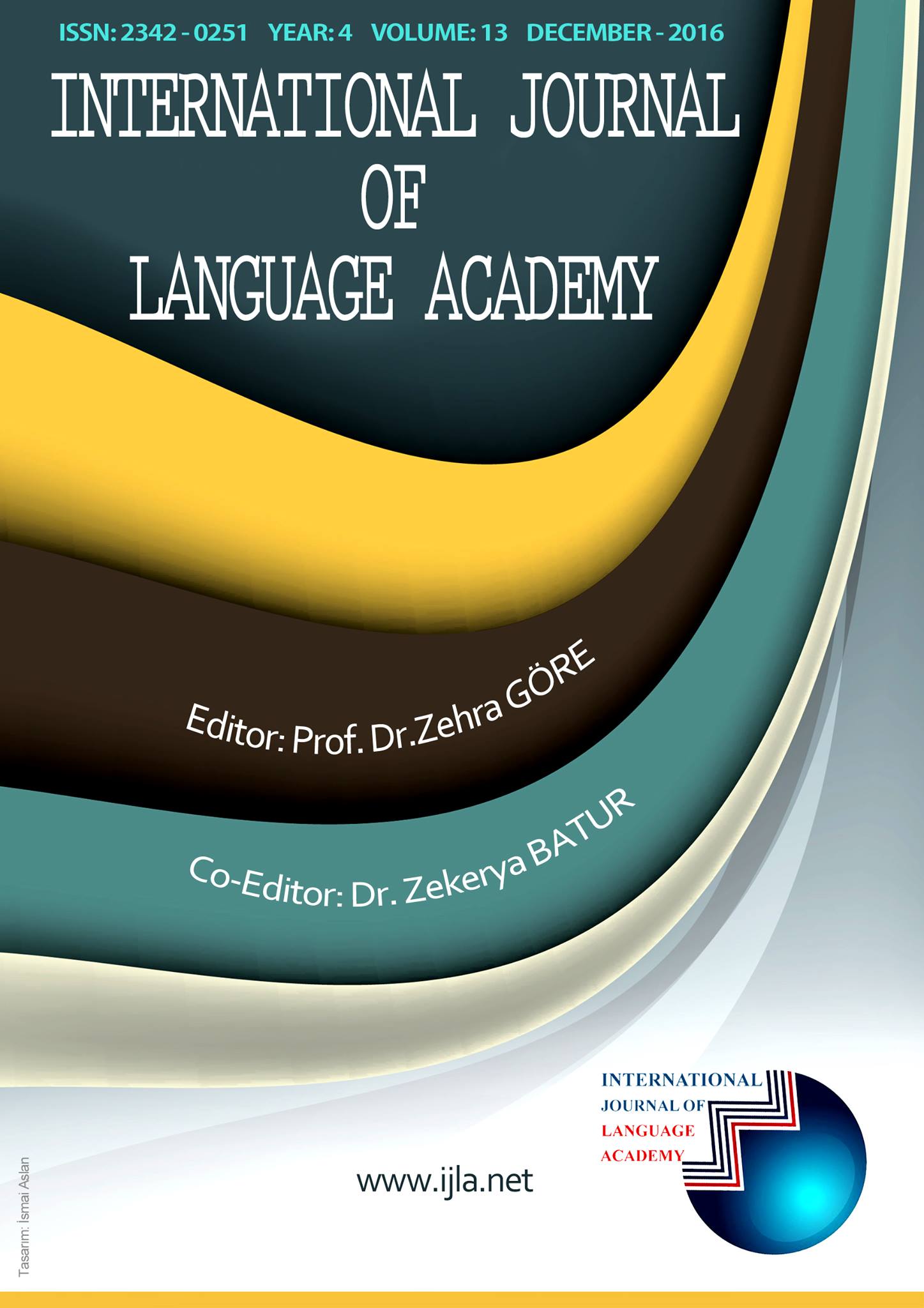Author :
Abstract
Günümüzde fiziksel ve sanal sınırlar, teknolojinin bir bireyin hayal edemeyeceği kadar büyük ve hızlı olan etkileri sayesinde küçülmektedir. Şüphesiz teknoloji; eğitim teknolojileri, sağlık teknolojileri ve çeviri teknolojileri gibi kendisinin çözüm ürettiği alanlarla özdeşleştirilmektedir. Çeviri görevlerinin oldukça sıkı olan son teslim tarihlerinden dolayı, çağımızda çeviri teknolojilerinin kullanımı bir tercih meselesinden daha çok gereksinim hâlindedir. Aynı zamanda çeviri teknolojileri, asıl görevi çeviri sektörüne iyi yetişmiş ve nitelikli eleman sağlamak olan çeviri eğitimi programlarının vazgeçilmez bileşeni konumundadır. Bu araştırma, çeviri teknolojilerinin çeviri sektöründen daha önce çeviri teorileri tarafından ele alındığını öne sürmektedir. Fakat kuramsal çeviribilim sahasının çeviri teknolojilerine yeterince değinmediği iyi bilinen bir gerçektir. Bundan dolayı çeviribilim bölümlerinde görevli akademisyenler, çeviri sektörü tarafından uzun bir süredir eleştirilmektedir. Bu çalışma, çeviri kuramlarının çeviri teknolojilerinin gelişimine sağladığı katkıları ortaya çıkarmaktadır. Ayrıca bu araştırma, çeviri teknolojilerinin altyapı ve işleyişlerini belirten çeviri teorilerinin bazı özel kısımlarını da ele alacaktır. Son olarak ise bu çalışmada çeviri teknolojilerinin gelişim ve öğretimi ile ilgili bazı özel konuların, çeviri teorilerinin öğretilerinin derinlemesine irdelendiğinde daha iyi anlaşılacağı üzerinde durulmaktadır.
Keywords
Abstract
Today, physical and virtual borders are shrinking thanks to technology whose footprints are greater and faster than one can imagine. Beyond the shadow of a doubt, technology is associated with the areas for which it offers solutions such as education technologies, health technologies, translation technologies, etc. Nowadays using translation technologies is somehow a necessity rather than a choice in professional settings due to the strict deadlines of translation briefs. Also, translation technologies are indispensable components of translator education programs whose main purpose is to prepare qualified and well-trained fellows for translation sector. This research asserts that translation technologies were addressed by translation theories even before the advent of translation industry. However, it is a well-known fact that theoretical translation studies did not focus on translation technologies very much. Thus academics working in translation studies discipline have been criticized by translation sector for a long time. This study illustrates the contributions of translation theories to the development of translation technologies. Besides, this paper will discuss some specific points of translation theories indicating the infrastructure and functions of translation technologies. Finally, it is argued that some specific issues related to both the development and teaching of translation technologies can be better understood if the teachings of translation theories are considered in depth.
Keywords
- Alcina, A. (2008). Translation Technologies: Scope, Tools and Resources. Target, 20.1, 79- 102.
- Austermühl, F. (2001). Electronic Tools for Translators. Manchester: St. Jerome Publishing.
- Austermühl, F. (2006). Training translators to localize. A. pym, a. perekstenko and B.starink (Ed.) In Translation technology and its teaching, Tarragona: Intercultural Studies Group, 69-81.
- Balkul, H. İ. (2015). Türkiye’de akademik çeviri eğitiminde çeviri teknolojilerinin yerinin sorgulanması: müfredat analizi ve öğretim elemanlarının konuya ilişkin görüşleri üzerinden bir inceleme. (Questioning the place of translation technologies in Turkish academic translation education: An inquiry based on curriculum analysis and opinions of academics related to the topic) Unpublished Doctorate Thesis. Sakarya University.
- Bernardini, S. (2004). The Theory behind the practice. Translator training or translator education? K. Malmkjær (Ed.). In Translation in Undergraduate Degree Programmes. Amsterdam and Philadelphia: John Benjamins. 17-29.
- Bowker, L. (2002). Computer-aided translation technology: A practical introduction. Ottowa: University of Ottawa Press.
- Bowker, L. (2015). Computer-aided translation: Translator training. C. Sin-wai (Ed.). In The routledge encylopedia of translation technology. New York: Routledge, 88-104.
- Buzelin, H. (2005). Unexpected alies: How latour’s network theory could complement bourdieusian analyses in translation studies. The Translator, 11 (2), 193-218.
- Chesterman, A. (2000c). What constitutes “progress” in Translation Studies? B. E. Dimitrova (Ed.), Översättning och tolkning. Rapport från ASLA:s höstsymposium, Stockholm, 5-6 November 1998. Uppsala: ASLA, 33-49.
- Doherty, S. (2016). The impact of translation technologies on the process and product of translation. International Journal of Communication, 10, 947-969.
- EU Directorate-General for Translation. http://ec.europa.eu/dgs/translation/faq/index_en.htm (Retrieved on 11/8/2016)
- Fernandez, A. (2009b). The role of computer assisted translation in the field of software localization. D. Walter and V. Hoste (Eds.). In Evaluation of translation technology. Linguistica Antverpiensia New Series - Themes in Translation Studies 8, pp. 179-194.
- Gouanvic, J-M. (2005). A bourdieusian theory of translation, or the coincidence of practical instances. The Translator, 11(2), 147-166.
- Holmes, J. (1988). The name and nature of translation studies. J. Holmes (Ed.). In translated! Papers on Literary Translation and Translation Studies. Amsterdam: Rodopi, 67-80.
- Hornby, M. S. (2006). The turns of translation studies. Amsterdam: John Benjamins Publishing Company
- Hutchins, W. J. (1986). Machine translation: Past, present, future. Chichester: Ellis Horwood.
- Kingscott, A. G. (1996). Translation, the 21 st century Horizon. Traduire, (168), 35-46.
- Lagoudaki, E. (2006). Translation memories survey 2006: Users’ perceptions around TM use. Proceedings of the ASLIB International Conference Translating & the Computer.1-29.
- Melby, A.(1998). Eight types of translation technology. American Translators Association, 4-9.
- Munday, J. (2001). Introducing translation studies: Theories and applications. New York: Routledge.
- O’Hagan, M. (2013). The impact of new technologies on translation studies: A technological turn? C. Millán & F. Bartrina (Eds.) In The Routledge handbook of translation studies. London, UK: Routledge, 503-518.
- Parlak, B. (2012). Akademik çeviri öğretimi ve çeviride meslekleşme sorunları. Avrupa Birliği Bakanlığı Çeviri Platformu Proceedings, İstanbul, 65-74.
- Pym, A. (2009). Exploring translation theories. Abingdon, Oxon and New York: Routledge.
- Pym, A. (2011a). What technology does to translating. The International Journal for Translation and Interpreting Research, 3(1): 1-9.
- Pym, A. (2013). Translation technology and translation theory-dialogue with anthony pym on localization. Chinese Translators Journal, 4(1). 61-64.
- Quah, C. K. (2006). Translation and technology. New York: Palgrave McMillan.
- Williams, J. (2013). Theories of translation. New York, NY: Palgrave Macmillan.
- Wolf, M. (2012). The sociology of translation and its “activist turn”. Translation and interpreting Studies, 7(2), 129-14.
- Zhang, C., & Cai, H. (2015). On technological turn of translation studies: Evidences and influences. Journal of Language Teaching and Research, 6(2), 429-434.





